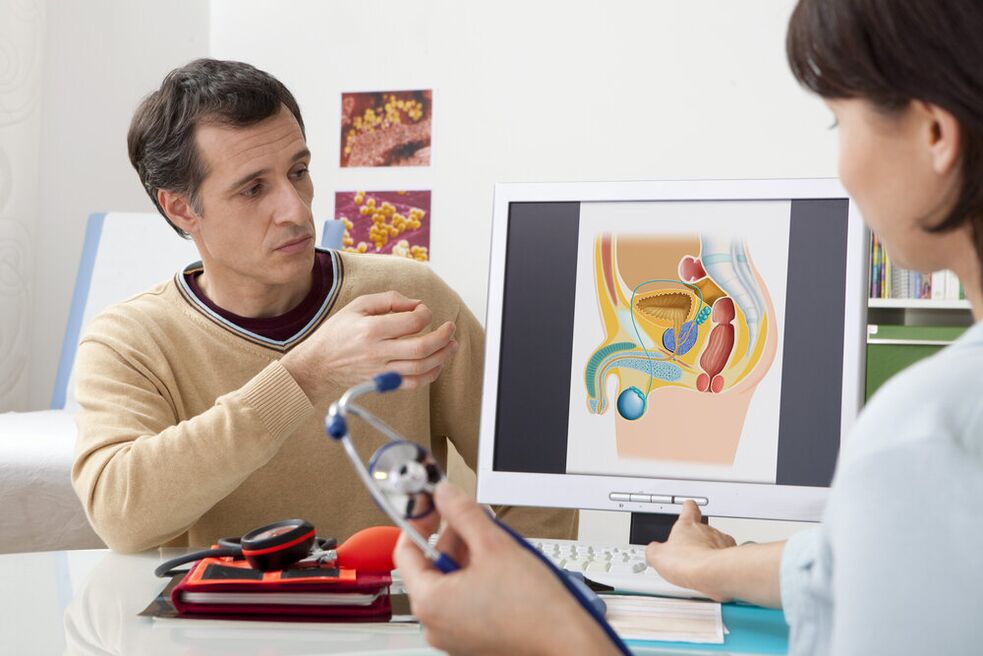Symptoms of prostatitis can be detected several days after the onset of the disease. Depending on the age, individual condition of the patient and other nuances, the disease can manifest itself clearly or progress more calmly. Early access to a doctor and timely diagnosis ensure successful treatment, without complications and recurrence.

Risk group
Prostatitis in men is being diagnosed more and more. The nature of the disease is simple. The gland in its normal state is very small but increases suddenly, pressing on the urinary tract and vas deferens, causing problems with urine output and normal ejaculation. There are many reasons for the occurrence of the disease. The following patients are at risk:
- middle age or older;
- overweight obesity;
- smokers and alcoholics;
- people who have ever had diseases of the urogenital tract (urethritis, cystitis, orchitis, salpingitis, salpingitis, pyelonephritis);
- have an unusual sex life;
- the practice of intermittent coitus as the primary means of contraception;
- are being treated with strong drugs (hormonal agents, antibiotics).

A few decades ago, symptoms of the disease were observed in middle-aged and elderly patients. But today, the disease is more and more common among young men who are active and do not have any particular health problems. Urologists distinguish 4 types of prostatitis: acute and chronic infectious, nonbacterial, prostatic failure.
The acute infectious form is more common in young, sexually active men. It is caused by bacteria that have entered the urethra and ureters. The source of infection is usually the causative agent of sexually transmitted diseases: streptococci, gonorrhea, spirochetes, Trichomonas, chlamydia. In some cases, bacteria enter the urethra from the rectum. This occurs when genital hygiene is inadequate. In the absence of adequate treatment, acute infectious prostatitis can become chronic. It is characterized by periods of rest interspersed with a sudden decline in health. As the disease progresses, attacks become more frequent and last longer.
The onset of the disease: how to determine it
The first symptoms of prostatitis are easy to confuse with the manifestations of other diseases. That is why patients do not rush to see a doctor but arbitrarily take pain relievers and fever reducers. One warning sign is going to the bathroom too often. The man begins to notice little, dark or almost transparent urine. Gradually, the process of passing urine becomes painful, itchy and burning sensation in the urethra, the external genitalia become irritated and red.

Another characteristic manifestation is a frequent feeling of full bladder. The overgrown gland presses on the ureter, urine is secreted in drops or leaks spontaneously. You may urinate at night and may release pus, urine, or mucus from the urethra.
Almost simultaneously observed sexual dysfunction. An enlarged prostate blocks the flow of testosterone, a man notices a decrease in libido, premature ejaculation, impaired erection.
Against the background of the inflammatory process and failures in the genital area, the patient may become tense, irritable, develop aggressiveness or have a depressed, depressed mood.
Fatigue is very common. An active person will quickly get tired, sleepy, but even a long sleep does not bring a feeling of refreshment. Reduced effectiveness, the body is unable to fight the infection. As a result, even a common cold ends up with complications that worsen the patient's condition.
Signs and expressions

Symptoms of prostatitis in men can be overt or insidious. It all depends on the individual characteristics of the body, the presence or absence of other chronic diseases, age and other important points. Usually the first characteristic manifestations occur days or weeks after the onset of the disease. Including:
- repeated urination;
- pain in the urethra during and after urination;
- local edema in the genital area;
- feeling that the bladder is not completely empty;
- problems with urine output;
- dull pain in the lower abdomen;
- discomfort in the scrotum and lower back;
- general unrest;
- short-term temperature rise.
With prostatitis, the patient may have difficulty sleeping and appetite, often with constipation, alternating diarrhea. The main symptoms of prostatitis, which are characteristic of the nonbacterial form, appear and disappear, becoming more pronounced or significantly weakened. With chronic prostatitis, the characteristic symptoms do not go away on their own for a long time.
They can be so indifferent that men don't show interest, due to poor health leading to colds, stress, and fatigue at work. According to statistics, nearly a quarter of people with the disease do not feel any discomfort for several months after the onset of the disease.

Acute infectious prostatitis, the symptoms of which become noticeable after a few days, are manifested by a sharp increase in temperature, burning and pain in the urethra, a constant need to go to the toilet. The patient feels chills and fever. Stool problems may occur. During inflammation, tissues become loose and vulnerable. The patient refrains from defecation, the stool is compressed and difficult to pass through the rectum. In severe form, the development of hemorrhoids, the appearance of cracks in the rectum and other unpleasant consequences are possible.
A prominent symptom of acute prostatitis is the presence of traces of blood and pus in the urine. Urine becomes cloudy and has an unpleasant odor. Urine comes out in drops or lingers for several hours, causing severe swelling. Everything is about an acute inflammatory process. At the first signs of prostatitis, you should contact a specialist, who will be referred to a urologist.
Prostatitis and its symptoms
Prostatitis is a non-inflammatory form of prostatitis. It occurs in 30% of middle-aged and older men. The disease progresses in a latent or acute form, with it presenting a series of features characteristic of non-infectious prostatitis.
The main difference of this form of the disease is the absence of high temperature, edema, weakness. At the same time, the patient constantly feels pain of a very different nature: tugging, aching, sharp pain. It may be localized to the perineum, extending to the lower back, legs, lower abdomen, scrotum, or penis. Pain occurs at rest or with exertion; blocking pain relievers or using strong drugs that can relieve pain. Antibiotics do not help, as there is no inflammatory component.
An enlarged prostate is characterized by problems with urination. Among them:
- murmuring stream;
- drip leaks;
- incomplete emptying of the bladder;
- frequent false urges;
- dysuria (complete absence of urine).
How to diagnose?

With any prostatitis nature, the main thing is not to delay treatment for a long time. Only a urologist can understand what form the disease will take and what methods to choose for a quick recovery. The peculiarity of prostatitis is that the disease is easily confused with other diseases.
For example, problems with urination are characteristic of chronic or acute urethritis or cystitis. Pain in the lower abdomen and blood in the urine can signal pyelonephritis.
Finally, a general decline in health characterizes a whole list of diseases, from the common flu to rectal cancer.
A series of tests and ultrasounds to evaluate the condition of the prostate will help avoid mistakes and improper treatment.
If the cause of the disease is a urinary tract infection, then it must be cured and only then proceed to eliminate the symptoms of prostatitis.
A few decades ago, it was believed that the disease was typical for older men, but today, quite young people who lead an active lifestyle also suffer from this disease. After finding the characteristic symptoms, you should immediately consult a doctor who will diagnose and choose the correct method of treatment.

























